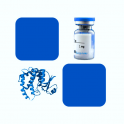
- Remove this product from my favorite's list.
- Add this product to my list of favorites.
Products
Viewed products
Newsletter
 |  |  |  |  |  |

Background
Integrin alpha 2 beta 1 is one of twelve integrin family adhesion receptors that share the beta 1 subunit. It is a receptor for laminin, collagen, collagen C-propeptides, fibronectin and E-cadherin. It recognizes the proline-hydroxylated sequence G-F-P-G-E-R in collagen. It is responsible for adhesion of platelets and other cells to collagens, modulation of collagen and collagenase gene expression, force generation and organization of newly synthesized extracellular matrix. Integrin ITGA2:ITGB1 acts as a receptor for Human rotavirus A and Human echoviruses 1 and 8. DGEA inhibited rotavirus binding to alpha2beta1 and infectivity. In a novel process, integrin-using viruses bind the alpha2 I domain of alpha2beta1 via DGE in VP4 and interact with alphaXbeta2 (via GPR) and alphaVbeta3 by using VP7 to facilitate cell entry and infection.
Source
Recombinant Human ITGA2&ITGB1 Heterodimer Protein, His Tag&Tag Free (IT1-H52W6) is expressed from human 293 cells (HEK293). It contains AA Tyr 30 - Thr 1132 (ITGA2) & Gln 21 - Asp 728 (ITGB1) (Accession # P17301-1 (ITGA2) & P05556-1 (ITGB1)).
Predicted N-terminus: Tyr 30 (ITGA2) & Gln 21 (ITGB1)
Molecular Characterization
Human ITGA2&ITGB1 Heterodimer Protein, His Tag&Tag Free, produced by co-expression of ITGA2 and ITGB1, has a calculated MW of 127.6 kDa (ITGA2) and 83.7 kDa (ITGB1). Subunit ITGA2 is fused with an acidic tail at the C-terminus and followed by a polyhistidine tag and subunit ITGB1 contains no tag but a basic tail at the C-terminus. The reducing (R) protein migrates as 150-160 kDa (ITGA2) and 105-135 kDa (ITGB1) respectively due to glycosylation.
Endotoxin
Less than 1.0 EU per μg by the LAL method.
Purity
>95% as determined by SDS-PAGE.
Formulation
Lyophilized from 0.22 μm filtered solution in 50 mM Tris, 150 mM NaCl, pH7.5 with trehalose as protectant.
Please see Certificate of Analysis for specific instructions.
For best performance, we strongly recommend you to follow the reconstitution protocol provided in the CoA.
Storage
For long term storage, the product should be stored at lyophilized state at -20°C or lower.
Please avoid repeated freeze-thaw cycles.
This product is stable after storage at:
-20°C to -70°C for 12 months in lyophilized state;
-70°C for 3 months under sterile conditions after reconstitution.
Bioactivity
Please refer to product data sheet.
(1) "[Clinical and bioinformatics analysis of the relationship between LAMA3 DNA methylation expression and platinum resistance and prognosis in epithelial ovarian cancer]"
Chen, Zhang, Huang et al
Zhonghua Fu Chan Ke Za Zhi (2024) 59 (6), 454-464
(2) "Potential Involvement of M1 Macrophage and VLA4/VCAM-1 Pathway in the Valvular Damage Due to Rheumatic Heart Disease"
Xian, Li, Bai et al
Front Biosci (Landmark Ed) (2024) 29 (6), 219
(3) "Thrombospondin-4 deletion does not exacerbate muscular dystrophy in β-sarcoglycan-deficient and laminin α2 chain-deficient mice"
Zarén, Gawlik
Sci Rep (2024) 14 (1), 14757
Showing 1-3 of 5462 papers.
Follow us